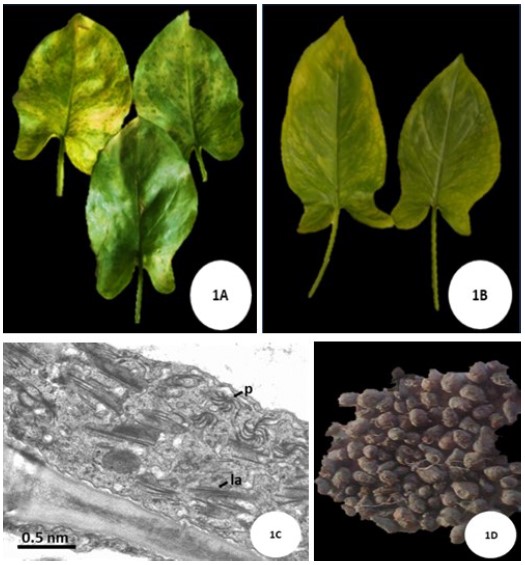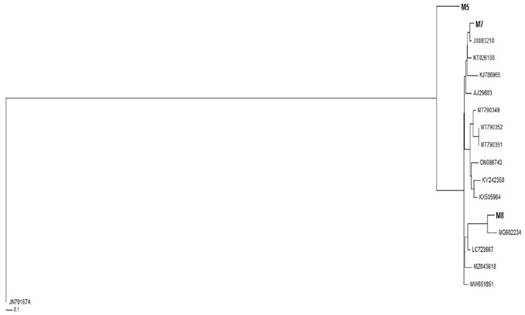Xanthosoma riedelianum is known by several common names as cocoyam, malanga (USA), yautia, tannia (Caribbean regions), tiquisque or malangay (Central America countries) and tayaó, mangará, mangareto or mangarito in Brazil (Giacometi and Léon, 1994; Kinupp and Lorenzi, 2021). So far, there is no consensus on the exact origin of the X. riedelianum, but records of its occurrence extend from Mexico to Brazil (Madeira et al., 2015). Plants of X. riedelianum were domesticated during pre-Columbian period and consumed by the indians of the Tupi Guarani ethnic group long before the occupation of the New World (Azevedo-Filho, 2012). According to Souza et al. (2018), this plant is an important in the group of the tropical unconventional food plants (UFPs) belonging to Araceae family and, in the world, 0.362 million tons of your tubers are produced mainly in Cuba, Venezuela, El Salvador, Peru, and Dominican Republic.
One of the advantages of X. riedelianum cultivation is that its leaves can be used in human food, unlike others Xanthosoma species, which only rhizomes are edible (Madeira et al., 2015). Among Araceae, the genera Colocasia and Xanthosoma are the UFPs species most used for human consumption and viruses are among the most economically important pathogens of these crops, resulting in significant yield losses (Kidanemariam, et al., 2022). Dasheen mosaic virus (Dasheen mosaic virus-DsMV, Potyvirus) is the most important virus that infects Araceae Family and it is reported throughout the world in wild, ornamental and UFPs species (Yusop et al., 2019; Varela-Benavides and Montero-Carmona, 2017). In Alocasia, Colocasia and Xanthosoma genera, the DsMV occurrence is frequently been reported (Kidanemariam et al., 2022). However, a DsMV strain that exclusively infects Vanilla spp. has also been described (Wang et al., 2017). DsMV is spread by vegetative propagation, transmitted non-persistently by aphids of the genus Aphis and Myzus (Zettler and Hartman, 1987; Elliot et al., 1997). The first report of DsMV was done in corms of Zantedeschia elliottina (golden calla lily) imported into the United States of America from the Netherlands (Zettler et al., 1970). The natural DsMV detection, in Central America, was reported in Colocasia esculenta (eddo or dasheen) and Xanthosoma spp. in Puerto Rico, Venezuela, Trinidad, Solomon Islands and Costa Rica (Ramirez, 1985). In Brazil, DsMV had been reported in UFPs species, like Colocasia esculenta (taro) and Amorphophallus konjac (voodoo lily) (Rodrigues et al., 1984; Chagas et al., 1993) and also in some ornamental species, as Alocasia macrorhiza (giant taro), Xanthosoma atrovirens (mouse-cup taro), Dieffenbachia amoena (dumb cane) and others (Rodrigues et al., 1984; Rivas et al., 2003; Varela-Benavides and Montero-Carmona, 2017). DsMV causes severe damage in different aroid species, which can be attenuated by meristem culture (Chen et al., 2001; Valverde, et al., 1997). Therefore, the objective was to identify the virus associated with viral diseases in X. riedelianum plants in Brazil.
Three samples of X. riedelianum plants (isolates M5, M7 and M8) from an experimental field located in the municipality of Monte Alegre do Sul (São Paulo State), showing foliar symptoms of mosaic, feathery mottle and vein clearing patterns (Figures 1A, 1B) were collected to identify the virus. Symptomatic and asymptomatic leaf samples were submitted to transmission electron microscope (TEM) observations, mechanical transmission to experimental plants, serological test (DAS-ELISA) with potyvirus group antiserum (AGDIA®), total RNA extraction and RT-PCR performed with primers set designed to anneal to the cylindrical inclusion (CI) genomic regions of Potyvirus according to Ha et al. (2008).

Figure 1 A) Leaves of X. riedelianum showing symptons of mosaic and yellowing. B) Leaves of X. riedelianum showing vein clearing patterns symptons. C) Photomicrograph of the leaf parenchyma cell of X. riedelianum, naturally infected by the dasheen mosaic virus (DsMV), an ultrathin section of the cell cytoplasm showing lamellar inclusions “la” and pinwheels “p”, characteristic of Potyvirus. D) Rhyzomes of X. riedelianum used as subsistence foods.
The products amplified by RT-PCR were eluted from the agarose gel, using the “Concert Rapid Gel ExtractionSystem” (Life Technologies) and were linked in pGEM-T vector (Promega) and used for the transformation of competent cells of Escherichia coli (DH5-α) and sequenced by the chain termination reaction technique, using the ABI 377 automatic sequencer and the “ABI kit PRISM BigDye Terminator Cycle Sequencing Ready Reaction Kit - Ampli Taq DNA Polymerase” (Perkin Elmer). The sequence alignments obtained in both directions were done with the aid of the program Sequencer 3.1 (Gene Codes Corporation) and comparisons, with the existing sequences in GenBank, were made through of the “Basic Local Alignment Search Tool” (BLAST) program from the National Center for Biotechnology Information (NCBI), available at http://www.ncbi.nlm.nih.gov. The identity percentage at the nucleotide level among sequences was determined by PAUP v. 4.0b10 for Macintosh. The likelihood ratio test (LRT) for the nucleotide substitution models comparison was performed using Modeltest v. 3.06 (Posada and Crandall, 2001). The tree reconstruction was also performed under maximum likelihood (ML) criterion using PAUP.
Symptomatic plants were negative in host plants, positive to Potyvirus in DAS-ELISA and in leaf ultrathin sections observed at TEM revealed the presence of cilindrical inclusions (CI), pinwheels and laminar agregates characteristics of potyvirus in cytoplasma of infected cells (Figure 1C). RT-PCR from symptomatic and asymptomatic leaf samples amplified an expected band size of 700 bp (Ha et al., 2008). After sequencing, three sequences with 480, 633 and 684 bp were obtained from M5, M7 and M8 isolates, respectively. Sequences showed greater identity with DsMV isolates by the BLAST tool and were available on GenBank (M5: OQ408279; M7: OQ408280; M8: OQ 408281). After alignment and analyzes, the greatest identities were observed between Brazilian DsMV isolates (M5, M7 and M8) and others from different hosts and regions of the world (Table 1). It is important to mention that there is no genome sequence of Brazilian or Latin American isolates of DsMV available in GenBank.
Table 1 Identity among nucleotide sequences corresponding to the cylindrical inclusion region of dasheen mosaic virus (DsMV) isolated from Brazilian Xanthosoma riedelianum (M5, M7 and M8), compared with other DsMV isolates from different hosts and regions of the world.
| DsMV isolates – Host – Country | Identity (%) | ||
|---|---|---|---|
| M5 | M7 | M8 | |
| M5 | ͞ | 74.4 | 72.1 |
| M7 | ͞ | ͞ | 81.0 |
| M8 | ͞ | ͞ | ͞ |
| MG602234* – Xanthosoma sp. – Australia | 72.0 | 80.0 | 84.6 |
| JX083210 – Pinellia pedatissecta – China | 72.2 | 91.2 | 78.7 |
| KT026108 – Colocasia esculenta – India | 72.2 | 87.7 | 79.8 |
| AJ298033 – Zantedeschia aethiopica – China | 73.3 | 87.3 | 78.3 |
| MW651851 – C. esculenta – Vietnam | 76.0 | 84.4 | 78.9 |
| MT790349 – C. esculenta – Figi | 73.7 | 84.2 | 79.8 |
| MT790352 – C. esculenta – Figi | 72.5 | 82.5 | 78.9 |
| MT790351 – C. esculenta – Figi | 72.5 | 82.5 | 78.9 |
| ON086743 – C. esculenta – Papua New Guinea | 74.8 | 82.3 | 78.3 |
| KY242358 – C. esculenta –USA | 74.8 | 81.2 | 78.3 |
| LC723667 – Zantedeschia aethiopica – South Korea | 76.5 | 85.4 | 78.7 |
| MZ043618 – Typhonium giganteum – China | 73.7 | 83.3 | 78.3 |
| KJ786965 – Amorphophallus paeoniifolius – China | 73.7 | 83.1 | 77.1 |
| KX505964 – Vanilla tahitensis – Cook Islands | 73.3 | 82.3 | 75.8 |
* GenBank accession number, bold numbers correspond to the highest identity.
The phylogenetic analyzes as well as the tree topology reconstructed under ML methodology indicated that the M7 isolate formed a sister group with the DsMV isolate from Pedatisected pinellia from China (Figure 2). In addition, the M8 isolate shared a common ancestor with the DsMV isolated from Xanthosoma sp. from Australia, corroborating the analysis of identity percentage. However, M5 occupied a more basal position in the topology of the phylogenetic tree, in addition to having shared the lowest percentage of identities, indicating that it is a different DsMV isolate (Table 1, Figure 2).

Figure 2 Maximum likelihood phylogram of cylindrical inclusion partial sequences of dasheen mosaic virus (DsMV) isolated from Brazilian Xanthosoma riedelianum (M5, M7 and M8) and other DsMV isolates from different hosts and regions of the world reprented by GenBank accession number. Banana bract mosaic virus sequence (JN791674) was used as outgroup. The tree was constructed using the HKY + G nucleotide substitution model (G= 0.2029).
Although there are reports of the occurrence of DsMV in ornamental species of Xanthossoma, like X. atrovirens and X. sagitifolium (Rodrigues et al., 1984; Varela-Benavides and Montero-Carmona, 2017), until now this is the first occurrence the natural infection of X. riedelianum by DsMV in Brazil.
Studies on the occurrence of viruses in this plant species that is important, because its tubers (Figure 1D) are used in human food, as well as yam, taro, among others, which are a source of calories for people in situation of nutritional vulnerability and also a source of income for small farmers (Varela-Benavides and Montero-Carmona, 2017).
X. riedelianum is among numerous rustic plants found in tropical regions whose the majority of these species are starchy, classified as caloric and considered subsistence foods. Despite being a great source of carbohydrates, low productivity drove farmers away from its cultivation, due to the irregular size of the rhizomes and the low volume of production without commercial value (Madeira et al., 2015). Although, these plants have great economic importance worldwide since they are a source of calories for low-income people and of earnings for small farmers, few studies have been done with these unconventional foods (Varela-Benavides and Montero-Carmona, 2017).
The positive results of the DAS-ELISA, against universal antiserum potyvirus group and presence of cylindrical inclusion in the electron microscopy and the result of the RT-PCR, with the primers for CI followed by sequencing were decisive for the identification of the DsMV in X. riedelianum. This is the first report of the DsMV in this species of UFPs.











 texto en
texto en 


